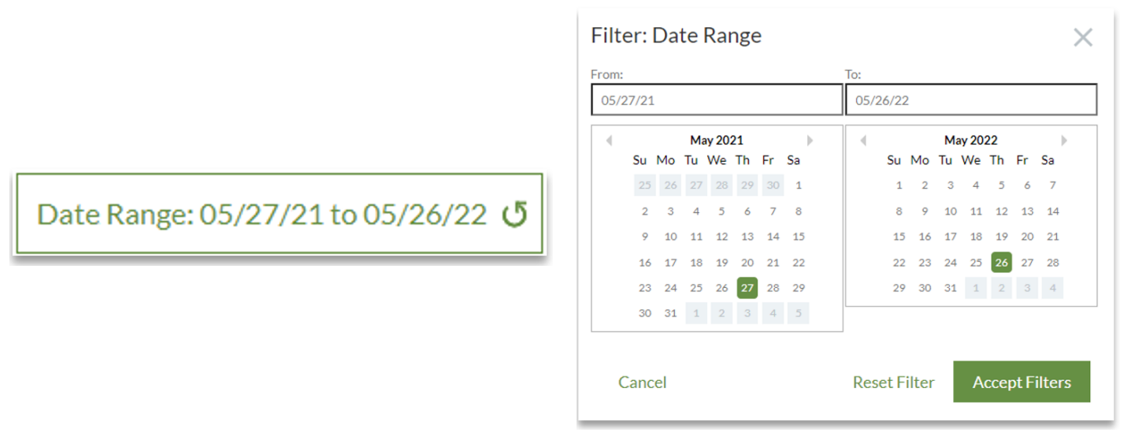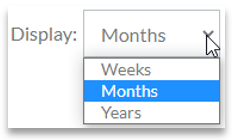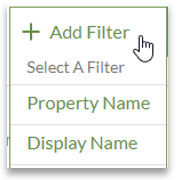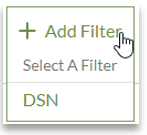Insights Report Filters
You can modify the data shown in a set of reports based on specific filters. This enables you to visualize and analyze data to make product improvements, revenue predictions, etc. This section describes the filters commonly used in all of the Ayla Insight reports. When you select a filter that is available in all reports, that same filter is set in all reports for which the filter is applicable. For all filters, you must select the Update Report button to activate the filter.
The Date Range Filter
In all of the Ayla Insights reports, you can use the Date Range filter to visualize and analyze data for a specific date range.

Left: Shows the Date Range Displayed in the Report
Right: Shows the Filter Dialog Box to Change the Date Range
The OEM Model Filter
In all of the Ayla Insights reports, you can use the OEM Model filter to visualize and analyze data for a specific OEM model or all OEM models. The OEM model is a specific product model created by the OEM to represent that the product is connected to the Ayla Cloud. This is also described as the name of the device that the OEM created.

Left: Shows the OEM Model Selected for the Report
Right: Shows the OEM Model Filter Dialog Box
The Software Version Filter
The Software Version refers to the firmware image (specific software version) associated with the devices. It is either the version of the Ayla firmware on the Wi-Fi module, or the version of the host MCU's firmware that runs on the OEM's microcontroller unit (MCU). The host MCU is the product’s MCU that communicates directly with the Ayla-enabled Wi-Fi module using the Ayla module drivers.

Left: Shows the Software Version Selected for the Report
Right: Shows the Software Version Filter Dialog Box
The Display Filter
All the report sets, except Notification Analysis, have a Display filter that enables you to show the data over weeks, months, or years. This filter is available for all report sets.

The Notification Type Filter
The Notification Type filter enables you to show device data based on a specific alert type (user-defined notification), such as SMS (short message service), email, push (set up and sent from server usually in real-time), forward, and so on. Notifications help monitor device activity. This filter is available in Device Details and Notification Analysis report sets.
Left: Shows the Notification Type Selected for the Report
Right: Shows the Notification Type Filter Dialog Box
Specific Filters for the Notification Analysis Report
In the Notification Analysis reports, there are additional filters enabling you to drill down to retrieve the following granular details:
- Property Name
- Display Name
To use either of these filters, click the Add Filter button, and then select the filter in the drop-down list, as shown in the following example:

The Property Name filter enables you to review and analyze device data for a specific device property. The property name usually refers to and matches the property on the device, i.e. Blue_LED.

Left: Shows the Property Name Selected for the Report
Right: Shows the Property Name Filter Dialog Box
Like the Property Name filter, the Display Name filter enables you to review and analyze device data for a specific device property, but this filter is based on the display name, not the property name. The display name refers to the actual device (product), i.e. kitchen_light_on.

Left: Shows the Display Name Selected for the Report
Right: Shows the Display Name Filter Dialog Box
The DSN Filter
The Notification Analysis and Datapoint Transmission Trends reports include a DSN filter enabling you to view specific datapoint transmission trends for a particular device by entering the device serial number (DSN).
To use this filter, click the Add Filter button, and then select the filter in the drop-down list, as shown in the following example:

This opens the DSN Filter dialog box where you enter the DSN to be filtered in the report.

Left: Shows the DSN Being Filtered in the Report
Right: Shows the DSN Filter Dialog Box
Updated 6 months ago
